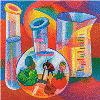Chemical and Biomolecular Engineering, Department of: Papers in Subdisciplines

Papers in Biotechnology
Date of this Version
August 2005
Abstract
Chitosan [<(1-4)-2 amino-2-deoxy-d-glucose], the natural polyaminosaccharide derived from N-deacetylation of chitin [<(1-4)-2 acetamide-2-deoxy-d-glucose], has been shown to possess attractive biological and cell interactive properties. Recently chitosan and chitosan analogs have also been shown to support the growth and continued function of chondrocytes. In the present study, chitosan substrates are crosslinked with a func-tional diepoxide (1,4 butanediol diglycidyl ether) to alter its mechanical property, and the viability and proliferation of the canine articular chondrocytes seeded on the crosslinked surface are further assayed. Of interest is the impact of substrate stiffness on the growth and proliferation of articular canine chondrocytes. Cross linked scaffolds were also sub-jected to degradation by chitosanase to examine the impact of cross linking on enzyme- assisted degradation. The hydrophilicity and compression modulus of the crosslinked sur-faces were measured via contact-angle measurements and compression tests, respec-tively. Scanning electron microscopy (SEM) and fluorescent staining were used to ob-serve the proliferation and morphology of chondrocyte cells on noncrosslinked and crosslinked surfaces. The crosslinked chitosan was found to be nontoxic to chondrocytes and more hydrophilic. Its compression modulus and stiffness increased, which may im-prove the scaffold resistance to wear and in vivo shrinkage once implanted. The in-creased stiffness also seemed to serve as an additional mechanical stimulus to promote chondrocyte growth and proliferation. The cell morphology on crosslinked scaffolds seen by SEM and fluorescent stain was the typical chondrocytic rounded shape. The method proposed provides a nontoxic way to increase the mechanical strength of the chitosan scaffolds.


Comments
This article is a preprint of an article published in © Journal of Biomedical Materials Research Part A Volume 75A, Issue 3, Pages 742-753 Published Online: 18 Aug 2005 Copyright © 2005 Wiley Periodicals, Inc., A Wiley Company Digital Object Identifier (DOI) 10.1002/jbm.a.30489 This article is available at the :publishers site